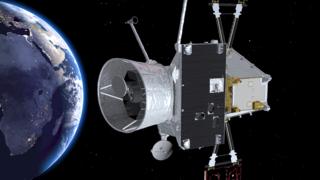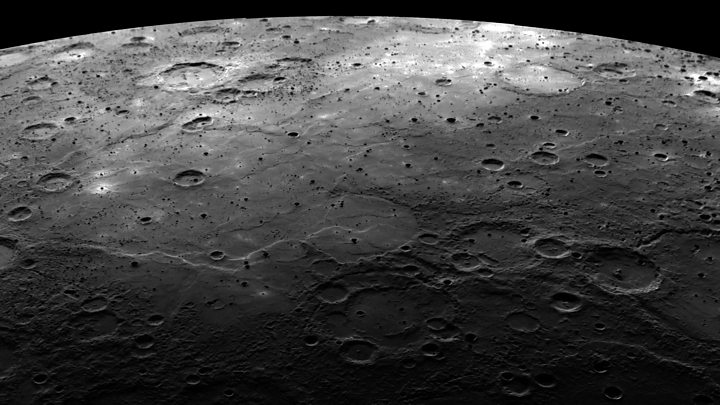
Image copyright
ESA
Artwork: The stacked probes will pass by the Earth at a distance of 12,700km
The joint European-Japanese mission to Mercury reaches a key milestone on Friday when it swings past the Earth.
The two-in-one BepiColombo space probe is using the gravity of its home world to bend a path towards the inner Solar System.
It will also bleed off some speed.
The mission needs to make sure it isn’t travelling too fast when it arrives at Mercury in 2025 or it won’t be able to go into orbit around the diminutive world.
“It would be so nice if we could take an express transfer and then we’d be there in a few months, but that doesn’t work for this mission,” Elsa Montagnon, the flight controller in charge of BepiColombo at the European Space Agency (Esa), told BBC News.

Media playback is unsupported on your device
As well as this coming flyby of Earth, Bepi will perform two similar manoeuvres at Venus and six at Mercury itself before slotting into position at the “iron planet”.
The only alternative would have been to give the spacecraft a colossal volume of fuel to use in a braking engine. An impractical solution.
Bepi will fly to within 13,000km (8,000 miles) of the Earth’s surface. Closest approach is expected at about 05:25 GMT (06:25 CEST).
It should be visible in darkened skies in the Southern Hemisphere, although not to the naked eye. A small telescope or binoculars will be needed.
Anyone who captures a picture is asked to upload the image to this Flickr group, or to post it on Twitter or Instagram using the hashtag #BepiColomboEarthFlyby.
Esa and its Japanese counterpart, Jaxa, have billed this pass as a “hello – and goodbye” moment.
“The flyby has an emotional effect,” said Johannes Benkhoff, the BepiColombo project scientist at Esa.
“It’s the last time that we can see the spacecraft from Earth, so we are inviting amateur and professional astronomers to observe it before it goes.”
The €3bn (£2.6bn) BepiColombo mission was launched in October 2018. It comprises two scientific satellites – the European Mercury Planetary Orbiter (MPO) and the Japanese Mercury Magnetospheric Orbiter (MMO) – that have been joined to a propulsion module for the long cruise.
Not only must the velocity of the spacecraft stack be controlled, but so too must its inclination with respect to the plane of the planets. Mercury’s orbit is offset by 6 degrees from that of Earth’s.
Already since the 2018 launch, the mission has completed one and a half loops around the Sun on its grand odyssey, travelling a distance of roughly 1.4 billion km. By they time it’s emplaced at Mercury and ready to begin science observations, Bepi will have completed 18 loops and covered more than 8.5 billion km.

Media playback is unsupported on your device
Mission scientists plan to switch on a number of the duo’s instruments for the Earth pass, to test and calibrate them. Unfortunately, the main camera on Europe’s MPO can’t operate because of its position in the stack. But engineers did fix small inspection cameras to the side of Bepi and these will be taking some black & white pictures of the Earth and Moon.
The next flyby will be of Venus in October. For most of the long journey, controllers on Earth will limit communication with the spacecraft to about one contact a week.
“Of course, even when we’re in quiet cruise, there are some maintenance operations to be done with the satellite. So, typically, every six months we are doing a thorough check out of the subsystems and the instruments where we activate units that are normally not active just to make sure they are still functioning okay,” explained Elsa Montagnon.
Image copyright
ESA
The stack is unpacked at Mercury to enable complementary observations
What science will BepiColombo do at Mercury?
The European and Japanese elements of the mission will separate when they get to Mercury and perform different roles.
Europe’s MPO is designed to map Mercury’s terrain, generate height profiles, collect data on the planet’s surface structure and composition, as well as sensing its interior.
Japan’s MMO will make as its priority the study of Mercury’s magnetic field. It will investigate the field’s behaviour and its interaction with the “solar wind”, the billowing mass of particles that stream away from the Sun. This wind interacts with Mercury’s super-tenuous atmosphere, whipping atoms into a tail that reaches far into space.
It’s hoped the satellites’ parallel observations can finally resolve the many puzzles about the hot little world.
One of the key ones concerns the object’s oversized iron core, which represents 60% of Mercury’s mass. Science cannot yet explain why the planet only has a thin veneer of rocks.
[email protected] and follow me on Twitter: @BBCAmos













